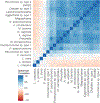Evaluation of the association between the concentrations of key vaginal bacteria and the increased risk of HIV acquisition in African women from five cohorts: a nested case-control study
- PMID: 29396006
- PMCID: PMC6445552
- DOI: 10.1016/S1473-3099(18)30058-6
Evaluation of the association between the concentrations of key vaginal bacteria and the increased risk of HIV acquisition in African women from five cohorts: a nested case-control study
Abstract
Background: Disruptions of vaginal microbiota might increase women's susceptibility to HIV infection. Advances in molecular microbiology have enabled detailed examination of associations between vaginal bacteria and HIV acquisition. Therefore, this study aimed to evaluate the association between the concentrations of specific vaginal bacteria and increased risk of HIV acquisition in African women.
Methods: We did a nested case-control study of participants from eastern and southern Africa. Data from five cohorts of African women (female sex workers, pregnant and post-partum women, and women in serodiscordant relationships) were used to form a nested case-control analysis between women who acquired HIV infection versus those who remained seronegative. Deep sequence analysis of broad-range 16S rRNA gene PCR products was applied to a subset of 55 cases and 55 controls. From these data, 20 taxa were selected for bacterium-specific real-time PCR assays, which were examined in the full cohort as a four-category exposure (undetectable, first tertile, second tertile, and third tertile of concentrations). Conditional logistic regression was used to generate odds ratios (ORs) and 95% CIs. Regression models were stratified by cohort, and adjusted ORs (aORs) were generated from a multivariable model controlling for confounding variables. The Shannon Diversity Index was used to measure bacterial diversity. The primary analyses were the associations between bacterial concentrations and risk of HIV acquisition.
Findings: Between November, 2004, and August, 2014, we identified 87 women who acquired HIV infection (cases) and 262 controls who did not acquire HIV infection. Vaginal bacterial community diversity was higher in women who acquired HIV infection (median 1·3, IQR 0·4-2·3) than in seronegative controls (0·7, 0·1-1·5; p=0·03). Seven of the 20 taxa showed significant concentration-dependent associations with increased odds of HIV acquisition: Parvimonas species type 1 (first tertile aOR 1·67, 95% CI 0·61-4·57; second tertile 3·01, 1·13-7·99; third tertile 4·64, 1·73-12·46; p=0·005) and type 2 (first tertile 3·52, 1·63-7·61; second tertile 0·85, 0·36-2·02; third tertile 2·18, 1·01-4·72; p=0·004), Gemella asaccharolytica (first tertile 2·09, 1·01-4·36; second tertile 2·02, 0·98-4·17; third tertile 3·03, 1·46-6·30; p=0·010), Mycoplasma hominis (first tertile 1·46, 0·69-3·11; second tertile 1·40, 0·66-2·98; third tertile 2·76, 1·36-5·63; p=0·048), Leptotrichia/Sneathia (first tertile 2·04, 1·02-4·10; second tertile 1·45, 0·70-3·00; third tertile 2·59, 1·26-5·34; p=0·046), Eggerthella species type 1 (first tertile 1·79, 0·88-3·64; second tertile 2·62, 1·31-5·22; third tertile 1·53, 0·72-3·28; p=0·041), and vaginal Megasphaera species (first tertile 3·15, 1·45-6·81; second tertile 1·43, 0·65-3·14; third tertile 1·32, 0·57-3·05; p=0·038).
Interpretation: Differences in the vaginal microbial diversity and concentrations of key bacteria were associated with greater risk of HIV acquisition in women. Defining vaginal bacterial taxa associated with HIV risk could point to mechanisms that influence HIV susceptibility and provide important targets for future prevention research.
Funding: National Institute of Child Health and Human Development.
Copyright © 2018 Elsevier Ltd. All rights reserved.
Conflict of interest statement
CONFLICTS OF INTEREST
RSM receives research funding, paid to the University of Washington, from Hologic/Gen-Probe for a study of human papilloma virus screening. JRL is on the Scientific Advisory Board for Prosetta Biosciences, Inc. All other authors report nothing to disclose.
Figures


Comment in
-
Vaginal microbes, inflammation, and HIV risk in African women.Lancet Infect Dis. 2018 May;18(5):483-484. doi: 10.1016/S1473-3099(18)30061-6. Epub 2018 Jan 26. Lancet Infect Dis. 2018. PMID: 29396005 No abstract available.
References
-
- UNAIDS. Global AIDS Update. Geneva, Switzerland, 2016.
-
- Fredricks DN, Fiedler TN, Marrazzo JM. Molecular identification of bacteria associated with bacterial vaginosis. N Engl J Med 2005; 353: 1899–911. - PubMed
Publication types
MeSH terms
Grants and funding
LinkOut - more resources
Full Text Sources
Other Literature Sources
Medical

